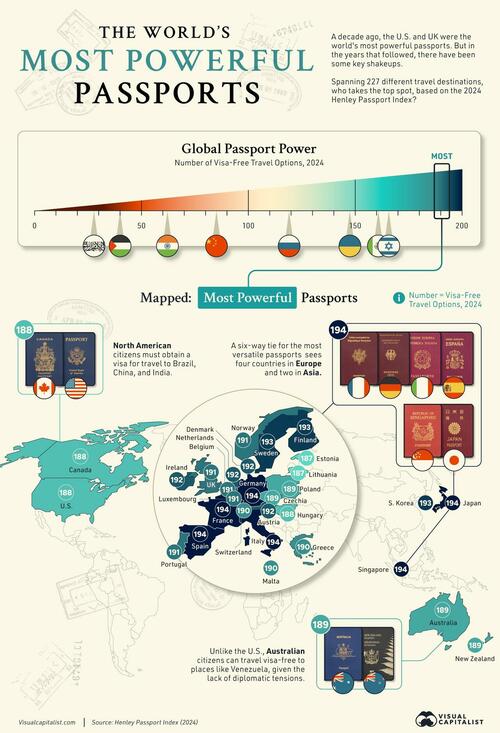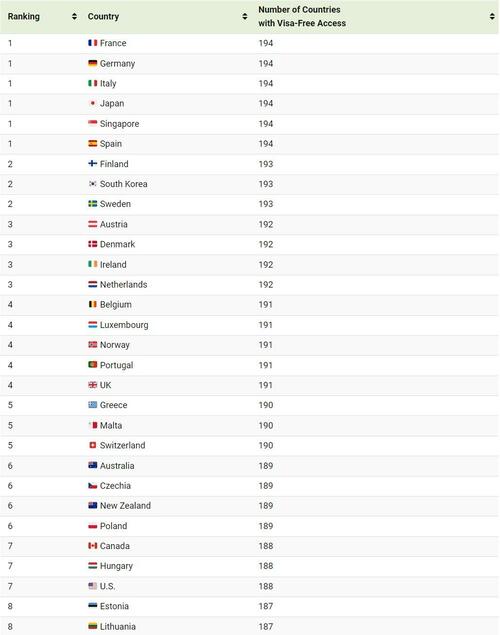
People around the world enjoy significantly greater travel freedom than they did just a couple decades ago.
In 2006, people could travel visa-free to 58 countries on average, while today that number has jumped to 111 destinations. Even in the last year, French, German, Spanish, and Italian citizens can now travel visa-free to three new countries.
This graphic, via Visual Capitalist's Niccolo Conte, shows the most powerful passports in 2024, with data from the annual Henley & Partners Passport Index.
Passport Strength in 2024
The world’s top passport is shared in a six-way tie, with visa-free access to 194 countries.
While Japan and Singapore ranked first for the last five years, four European countries—France, Germany, Italy, and Spain— climbed the ranks this year.
This comes as China granted visa-free access to these European countries and 50 other nations in efforts to revive tourism in a post-pandemic era. This follows a broader trend of countries waiving visas to encourage travel and boost economic activity. In the last eight years, for instance, both Germany and Singapore were granted visa-free travel to 35 new countries.
Finland, Sweden, and South Korea tie for second place in the rankings. In fact, the latter country has one of the highest numbers of visa waiver agreements in the world.
The U.S. ranks in seventh, one of its worst relative rankings ever. Over the last decade, its standing has fallen in rank given diplomatic tensions and its relative lack of openness to foreign tourists. For example, Brazil recently removed visa-free access to U.S. citizens for reciprocity reasons—the U.S. requires Brazilians to have a visa to travel to the country.
From a regional perspective, 23 of the top 30 passports are in Europe and the UK, three are in Asia, while two are in both North America and Oceania.
Changes Ahead
After many years in the works, U.S. travelers will need a visa to travel to Europe in 2025.
In most cases, applications should be processed in minutes, but some may take as long as a few weeks. Travelers in Canada, Mexico, and South America will also be required to fill out the application. The good news is that the visa will be valid for three years or the date a passport expires, depending on which one happens first.
By contrast, Indonesia is discussing allowing visa-free access to 20 countries to encourage tourism and investment in the country. It is the second Asian nation after Singapore that is eyeing visa waivers to China. Recently, Thailand and Malaysia have provided the world’s second-largest economy visa-free access thanks to its role as a key driver of tourism in these countries.
People around the world enjoy significantly greater travel freedom than they did just a couple decades ago.
In 2006, people could travel visa-free to 58 countries on average, while today that number has jumped to 111 destinations. Even in the last year, French, German, Spanish, and Italian citizens can now travel visa-free to three new countries.
This graphic, via Visual Capitalist’s Niccolo Conte, shows the most powerful passports in 2024, with data from the annual Henley & Partners Passport Index.
Passport Strength in 2024
The world’s top passport is shared in a six-way tie, with visa-free access to 194 countries.
While Japan and Singapore ranked first for the last five years, four European countries—France, Germany, Italy, and Spain— climbed the ranks this year.
This comes as China granted visa-free access to these European countries and 50 other nations in efforts to revive tourism in a post-pandemic era. This follows a broader trend of countries waiving visas to encourage travel and boost economic activity. In the last eight years, for instance, both Germany and Singapore were granted visa-free travel to 35 new countries.
Finland, Sweden, and South Korea tie for second place in the rankings. In fact, the latter country has one of the highest numbers of visa waiver agreements in the world.
The U.S. ranks in seventh, one of its worst relative rankings ever. Over the last decade, its standing has fallen in rank given diplomatic tensions and its relative lack of openness to foreign tourists. For example, Brazil recently removed visa-free access to U.S. citizens for reciprocity reasons—the U.S. requires Brazilians to have a visa to travel to the country.
From a regional perspective, 23 of the top 30 passports are in Europe and the UK, three are in Asia, while two are in both North America and Oceania.
Changes Ahead
After many years in the works, U.S. travelers will need a visa to travel to Europe in 2025.
In most cases, applications should be processed in minutes, but some may take as long as a few weeks. Travelers in Canada, Mexico, and South America will also be required to fill out the application. The good news is that the visa will be valid for three years or the date a passport expires, depending on which one happens first.
By contrast, Indonesia is discussing allowing visa-free access to 20 countries to encourage tourism and investment in the country. It is the second Asian nation after Singapore that is eyeing visa waivers to China. Recently, Thailand and Malaysia have provided the world’s second-largest economy visa-free access thanks to its role as a key driver of tourism in these countries.
Loading…






